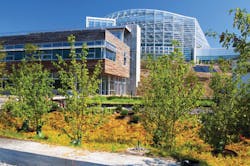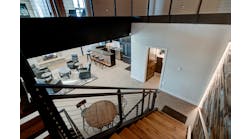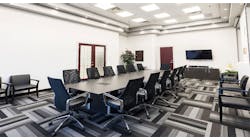Phipps Conservatory’s Center for Sustainable Landscapes Set to Make Living Building Challenge List
Most people in the construction industry are familiar with the U.S. Green Building Council’s Leadership in Energy and Environmental Design (LEED) program. A similar initiative introduced by the International Living Future Institute (ILFI) seeks to set a higher standard when it comes to advancing energy-efficient facilities. Called the Living Building Challenge (LBC), this program includes requirements such as net-zero energy and water usage, and comprises seven performance areas, including: site, water, energy, health, materials, equity, and beauty. To date, only three buildings in the nation hold this certification. However, the Phipps Conservatory’s Center for Sustainable Landscapes (CSL), located in Pittsburgh, may soon join this elite list.
“The CSL must be occupied and operated successfully for 12 months before it can be officially recognized as a living building,” explains Richard Piacentini, executive director of the Phipps Conservatory and Botanical Gardens. “The building was completed in December, so after a few months of tweaking the systems and 12 months of operating, we’ll know if it qualifies. I’m confident it will.”
To help document LBC compliancy, the $15-million, 24,350-sq-ft education, research, and administration complex contains a state-of-the art direct digital control building management system (BMS) that employs extensive metering to define and refine energy use. Features of the BMS include a notification system that alerts occupants that temperature, humidity, and air quality conditions are favorable for opening windows, while locking out mechanical systems.
Components that will help the CSL achieve LBC certification consist of a geothermal heating and cooling system that comprises 14 geothermal wells of 510-ft-deep boreholes with PEX tubing loops and a rooftop energy recovery unit that employs ground-source geothermal capacity. A solar array and vertical axis wind turbines produce enough electricity to offset 100% of the facility’s annual energy consumption.
“We worked with the solar and wind turbine installers to tie those energy sources into the building’s electrical distribution system,” says Michael Hanlon, president of Monroeville, Pa.-headquartered Hanlon Electric, the project’s electrical contractor.
To further reduce the building’s energy consumption, the center uses extensive daylighting via a large glass atrium, light shelves, and an interior daylight ceiling “cloud,” which maximizes the depth of daylight penetration into the space. Addressable dimming control was also incorporated.
“We programmed every lighting switch so that it can control any luminaire in the building,” says Hanlon. “In
addition, sensors identify natural light and motion, and then automatically adjust the lighting levels based on feedback. We also installed high-efficiency LEDs and T-5 fluorescent lamps throughout the facility for optimal energy conservation.”
According to Hanlon, finding products that met stringent LBC requirements proved to be one of the most demanding aspects of this project.
“Our biggest challenge was the time and paperwork it took to find and submit for approval the products that conformed not only to LBC qualifications, but also to LEED and Sustainable Site Initiative (SITES) requirements,” notes Hanlon.
To overcome this challenge, Hanlon Electric preplanned each task far in advance to ensure materials were onsite and ready for installation when needed.
In addition to its electrical systems, other energy efficiency features of the CSL include: low-emissivity windows; building materials that are locally produced, low VOC, and formaldehyde-free; a green roof; a rainwater harvesting system that stores storm water runoff in a 1,700-gal underground cistern, a 100,000-gal lagoon, and 80,000 gal of underground rain tanks; and permeable paving that enables the natural infiltration of site storm water.
In early 2014, Phipps Conservatory’s Center for Sustainable Landscapes could become the world’s first building to meet or exceed the three highest green standards — the Living Building Challenge, LEED Platinum, and Sustainable SITES Certification for landscapes.




